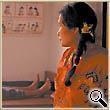Fearing the worst...
Gasping for air...
WE HAD FIRST HEARD about Cynthia Maung at a party on a rainy Seattle night in fall 1995. A public-radio reporter had told us about a young Burmese doctor, herself a refugee, who ran clinics on the Thai-Burma border.
Mother Teresa to Burmese refugees... in her 30s... fled Burma after the 1988 military crackdown... main clinic in Thailand... several thatched-hut clinics in rebel-controlled Burma... Everybody calls her, simply, Dr. Cynthia.
My husband, Tao, had finished his pediatric residency -- four years of life as a tired blur -- and we wanted to have an adventure, do something hands-on. In March 1996, we landed at Dr. Cynthia's main clinic in Mae Sot, Thailand, a dusty town about a 20-minute jog from the Burma border. For the next three months, Tao would see patients and teach pediatrics, while I would peel mountains of garlic, lead a dawn aerobics class and type Dr. Cynthia's field reports and grant applications.
The tin-roof clinic sits on the edge of parched rice paddies in Thailand's hottest province. The air smelled of blood and iodine, sewage and steaming rice. Everywhere, there were fuzzy chicks, suckling kittens, nursing moms. The place oozed with fertility. This was not what I had expected.
I had imagined, before we arrived, that we would see battle wounds like in "M*A*S*H," when the theme music plays and the choppers swoop down and the medics crouch low under rotor blades, carrying moaning men on stretchers. I had expected cowboy surgeons extracting shrapnel, nurses holding gauze over land-mine stumps, legions of muddy army boots. This was war, wasn't it?
In the slow heat of the first morning, I kept waiting for the arrival of bloody soldiers but kept seeing more and more women. Pregnant women. Women shivering with malaria. Women coughing from tuberculosis. Women bent over from diarrhea. Factory girls with ugly rashes on their legs and gashes on their hands. Emaciated ladies with glazed yellow eyes.
Every so often, a rickety blue pickup loaded with garlic and bananas skittered off the road where the pavement crumbled into dirt. Out jumped children, their scrawny brown legs covered with mosquito bites. Then a small parade of tired women unfolded from the back of the truck and shuffled into the clinic, leaving flip-flops at the door. By noon, the concrete stoop was covered with flip-flops, mismatched, dusty, smudged under the toes. No army boots.
Finally, I realized, this was it. This was war: waged by men, dumped in the laps of women.
"I didn't have much idea about war before I came here," Dr. Cynthia told me, "but everywhere I see the men go off to fight or get captured, and the women and children suffer most."
Dr. Cynthia has done much to reduce that suffering. In addition to the main clinic at Mae Sot, she ran a half-dozen smaller field clinics in jungle villages across the border in Burma -- including Chogali.
When we visited last year, Chogali had 29 babies, 56 other children, 148 adults, 60 bamboo houses, five elephants, one microscope, no electricity and no cars.
Gurgling blue PVC pipes Dr. Cynthia had installed to divert clean water from upstream meant the women didn't have to spend three hours a day hauling water in oil cans while the men were gone.
The teak-leaf nursery school she had built fed the children one good meal a day, monitored their vision and growth, screened for worms, immunized.
The latex squat latrines she had installed helped dry up dysentery and cholera. The training she gave midwives meant fewer mothers and babies died from infection. Her clinic treated malaria and malnutrition and snake bites.
The little orchid girls had seemed safe, playing with tiny white blossoms.
I do not mean to romanticize what was, essentially, a harsh subsistence. I just want you to know what was lost.

